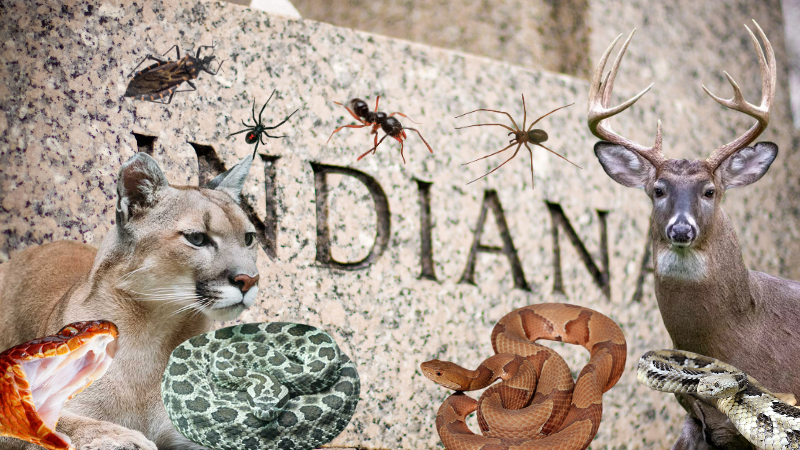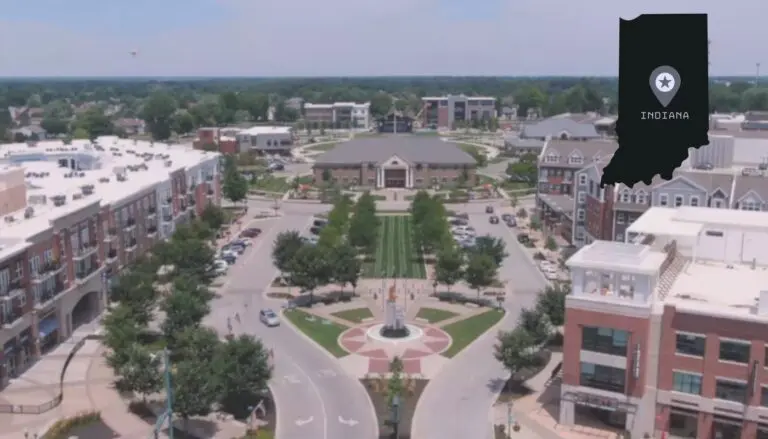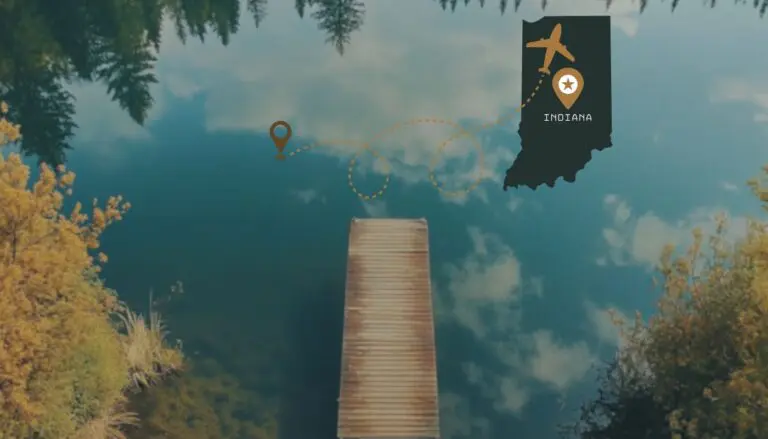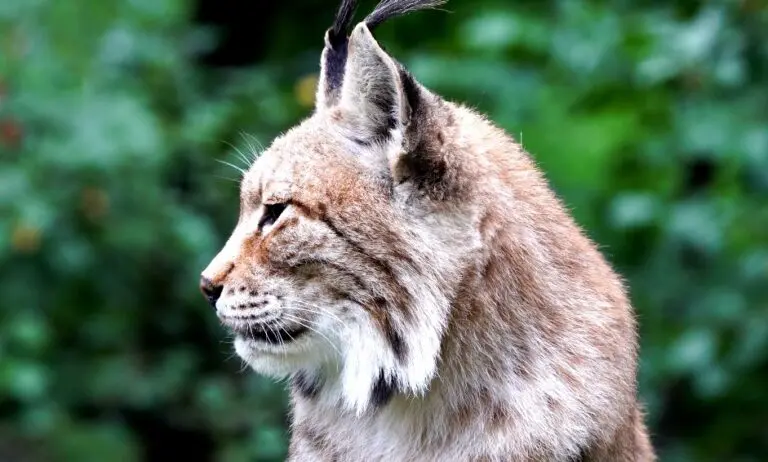Let’s kick things off with a creature that might already be closer than you think.
From venomous spiders to sneaky snakes, the wildlife in Indiana isn’t always as harmless as it seems.
Keep reading to learn more about the critters that demand a little extra caution when you’re exploring the outdoors…or even your own backyard.
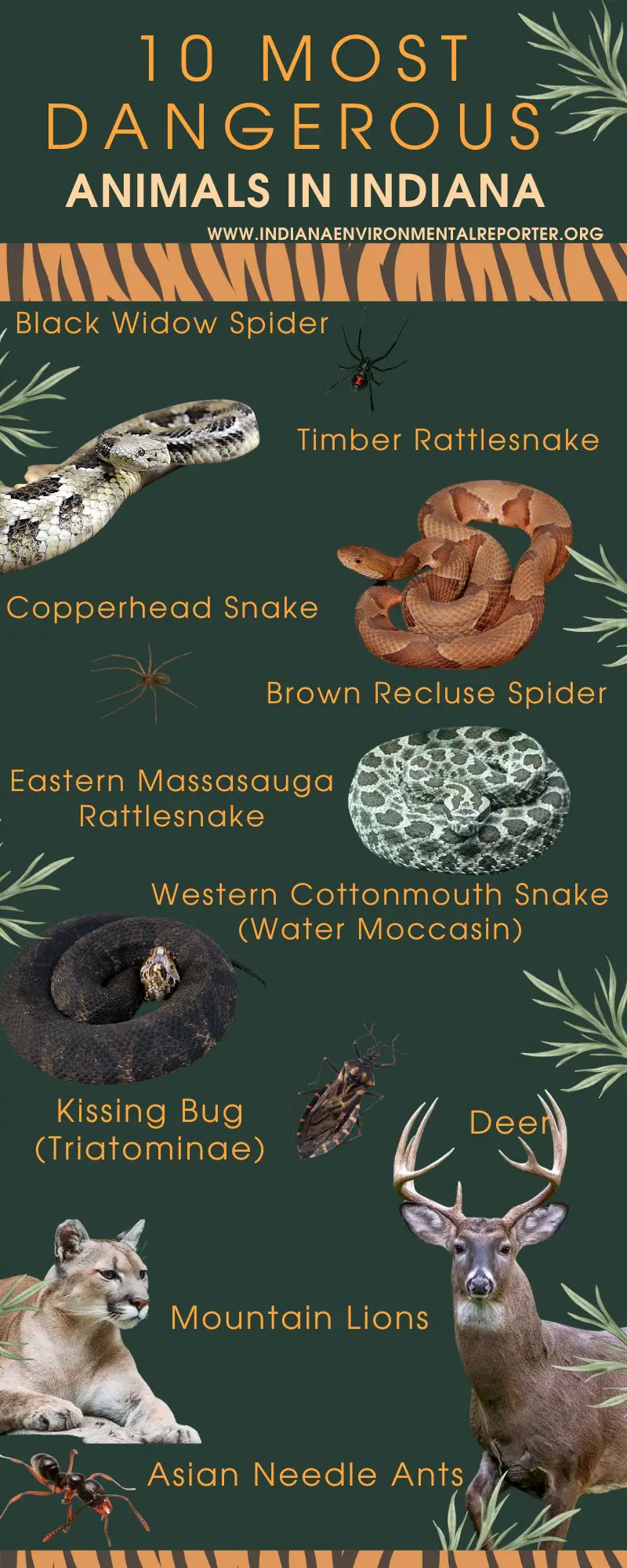
Table of Contents
Toggle10. Black Widow Spider
Famous for its glossy black body and red hourglass marking, the black widow spider is a beauty you definitely don’t want to get too close to.
Its venom contains a neurotoxin that targets the nervous system, and although fatalities are rare, the symptoms can be excruciating.
- Where they hide: Dark and undisturbed areas like basements, sheds, garages, and woodpiles.
- Why they’re dangerous: Bites can lead to severe muscle pain, cramps, sweating, and even chest tightness that mimics a heart attack.
9. Timber Rattlesnake
Next up is one of Indiana’s deadliest reptiles: the timber rattlesnake is venomous and highly reclusive, usually relying on camouflage to blend into its surroundings rather than confrontation.
- Where you’ll find them: South-central Indiana, in forests, marshes, and near woodpiles.
- Why they’re risky: Their venom destroys capillary walls, leading to severe internal bleeding, tissue damage, and even organ failure in severe cases.
This rattlesnake typically only strikes when it feels cornered, but its bite can result in permanent damage if medical attention isn’t sought quickly.
They hibernate during colder months, but in warmer weather, hikers, and campers should remain extra vigilant in areas with plenty of ground cover.
8. Copperhead Snake
The copperhead snake is easy to identify by its beautiful coppery color and hourglass pattern.
While not the most venomous snake, its bite can still cause serious medical issues, particularly for young children, pets, or the elderly.
- Where they lurk: Woodpiles, forested areas, marshes, and swamps.
- What to watch for: Their venom causes swelling, severe pain, and in rare cases, paralysis or life-threatening complications.
7. Brown Recluse Spider
This spider is a master of stealth, hiding in quiet, tucked-away spots in homes.
Its bites may start as mild irritation but can escalate into large, necrotic lesions that take weeks or even months to heal.
- Where they like to hide: Closets, basements, attics, and even inside shoes or gloves.
- What happens if bitten: Untreated bites can lead to fever, chills, and in rare cases, systemic infections that spread throughout the body.
6. Eastern Massasauga Rattlesnake
This small yet mighty rattlesnake is Indiana’s only native venomous snake species outside the southern half of the state. Their population is so sparse that they are listed as a federally threatened species.
- Where they can be found: Meadows, marshes, and riverbanks in northern Indiana.
- Why they’re a threat: Their venom can cause swelling, pain, and tissue damage. In rare cases, untreated bites can result in death.
Massasaugas are rarely aggressive and tend to flee rather than fight, but their bite demands immediate medical attention.
If you hear a rattling sound in grassy or marshy areas, step away slowly and give them plenty of room to retreat.
5. Western Cottonmouth Snake (Water Moccasin)
This semiaquatic snake is often spotted basking near water. While it’s not known for being aggressive, the cottonmouth can deliver a venomous bite if it feels threatened.
- Where they live: Swamps, ponds, and marshes.
- How they’re dangerous: Their venom causes tissue destruction, and bites can lead to necrosis and even shock.
Cottonmouths are known for their defensive behavior, often opening their mouths wide to reveal the white interior as a warning. If you enjoy fishing or kayaking in Indiana’s wetlands, keep an eye out for movement both in and around the water.
4. Kissing Bug (Triatominae)
Despite its sweet name, this little bug is anything but lovable. The kissing bug gets its name because it tends to bite the face of its victims, usually while they’re sleeping.
- Where they’re often found: Cracks, crevices, and hidden areas in or near homes.
- What makes them dangerous: Their bite can transmit Chagas disease, which may lead to heart damage, strokes, or other long-term complications.
3. Deer
Deer might seem like gentle giants, but they’re responsible for thousands of car accidents every year in Indiana. Collisions are not only dangerous for drivers and passengers but often deadly for the deer.
- Where they’re common: Near roads and highways, particularly at dawn and dusk.
- Why they’re risky: Over 14,000 deer-related crashes occur annually in the state, causing injuries, fatalities, and significant damage to vehicles.
Drivers should slow down in rural areas, especially during fall mating season when deer activity spikes. Installing deer whistles on your car or keeping high beams on when appropriate can help spot them sooner.
2. Mountain Lions
Silent and elusive, mountain lions are apex predators that rarely reveal themselves to humans. Though sightings in Indiana are rare, the possibility of an encounter exists, particularly in remote wilderness areas.
- Where they roam: Wilderness and abandoned coal mines.
- What makes them dangerous: Their powerful build and stealthy approach make them capable of lethal attacks, particularly on unsuspecting prey.
If you’re hiking or camping, travel in groups, make noise, and carry deterrents like bear spray. Should you encounter one, avoid running; instead, make yourself look larger and maintain eye contact while slowly backing away.
1. Asian Needle Ants
These tiny, venomous ants have made their way to Evansville, and their sting isn’t something you want to experience. Their arrival in Indiana is part of a larger invasion across the U.S., as they spread rapidly through forests and residential areas.
- Where they’re found: Forested areas, under rocks, and inside logs.
- What makes them risky: Their sting can cause severe allergic reactions, particularly in those who are sensitive to insect venom.
How to Stay Safe Around Wildlife
While nature offers plenty to enjoy, it’s always better to be prepared. Here are a few simple ways to reduce your risk of an unpleasant encounter with any of Indiana’s dangerous animals:
- Stay on trails when hiking and avoid walking through tall grass.
- Wear protective clothing like boots and gloves when outdoors.
- Keep your home sealed and clutter-free to avoid pests and spiders.
- Drive carefully in rural areas, especially at night or during mating seasons.
Related Posts:
- Indiana's Booming Job Market - Top Careers You…
- Evansville Population in 2025 - 10 Things You Should Know
- Lafayette, Indiana Crime Rate 2025 - What You Need to Know
- Why More Hoosiers Should Take Advantage of Free…
- Top 8 Research Tools Every Climate Scientist Should…
- Why Every Dental Practice Should Prioritize…








